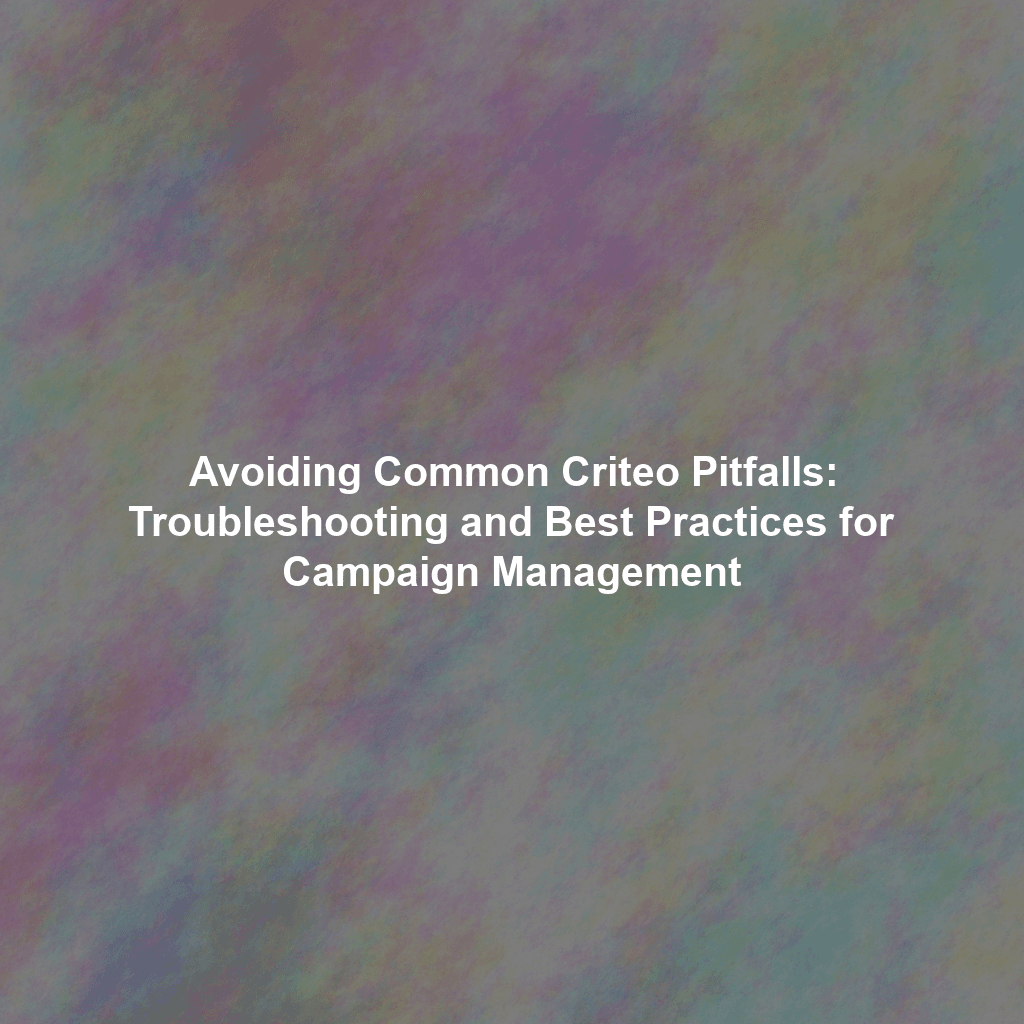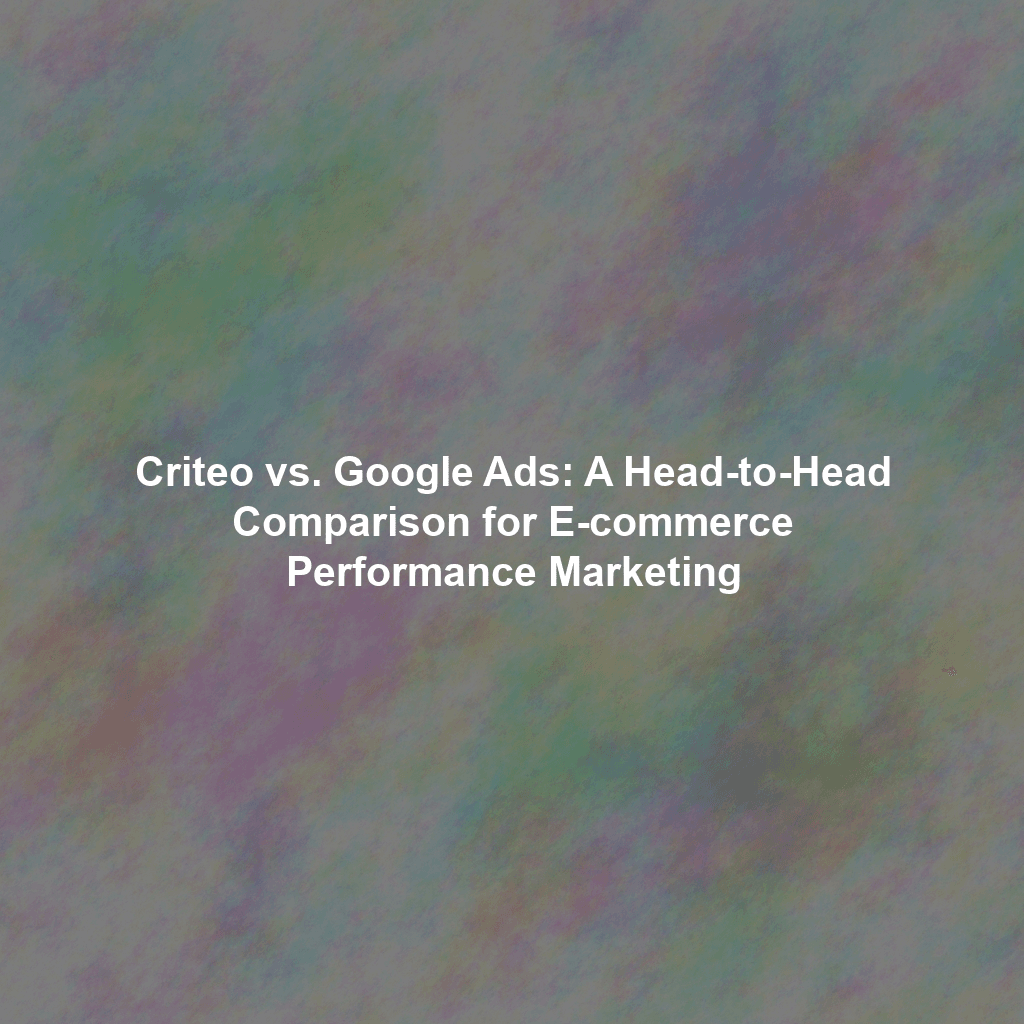Criteo is a powerful platform for retargeting and acquiring new customers, but even the most sophisticated tools can present challenges. Marketers often grapple with issues like low conversion rates, inflated costs per acquisition (CPA), and difficulty reaching the right audience. This article delves into common Criteo pitfalls, providing practical troubleshooting tips, campaign management best practices, and expert advice to help you overcome these obstacles and unlock the full potential of your campaigns. We’ll focus on real-world solutions to boost performance and ensure you’re getting the most out of your Criteo investment.
Understanding Common Criteo Challenges
Before diving into solutions, it’s crucial to understand the common roadblocks that can hinder Criteo campaign success. Recognizing these issues early allows for proactive adjustments and prevents wasted ad spend.
Low Conversion Rates: Is Your Audience Actually Ready to Buy?
A low conversion rate is a major concern for any marketer. With Criteo, this often stems from several factors. Are you showing ads to users who are too far up the sales funnel? Are your landing pages optimized for conversion? Are your ads compelling enough to entice a click and ultimately, a purchase?
High Costs Per Acquisition (CPA): Are You Bleeding Money?
High CPAs can quickly erode your marketing budget. This issue is often linked to poor targeting, irrelevant ad creatives, or inefficient bidding strategies. It’s crucial to continuously monitor and adjust these elements to maintain a healthy CPA.
Ineffective Targeting: Reaching the Wrong Audience
Criteo’s strength lies in its ability to target users based on their browsing behavior. However, if your targeting is too broad or relies on outdated data, you’ll likely reach irrelevant audiences, leading to wasted impressions and low engagement.
Troubleshooting Criteo Performance Issues: A Step-by-Step Guide
Now that we’ve identified the key challenges, let’s explore practical troubleshooting steps to address them.
Diagnosing and Fixing Low Conversion Rates
- Landing Page Optimization: Ensure your landing pages are relevant to your ad creative and offer a seamless user experience. Check for slow loading times, confusing navigation, and unclear calls to action. A/B test different landing page variations to identify what resonates best with your audience.
- Ad Creative Relevance: Your ads should accurately reflect the products or services being advertised. Use high-quality images and compelling ad copy that highlights key benefits and addresses customer pain points. Dynamic product ads (DPAs) are essential for retargeting, as they automatically showcase products users have previously viewed.
- Audience Segmentation: Segment your audience based on their behavior and purchase intent. Create separate campaigns for users who have browsed products, added items to their cart, or abandoned checkout. Tailor your messaging and offers to each segment to maximize conversion rates.
- Offer Optimization: Experiment with different offers, such as free shipping, discounts, or bundles, to incentivize purchases. Clearly communicate your offers in your ad creatives and landing pages.
- Checkout Process: Simplify your checkout process to reduce friction. Offer multiple payment options and ensure the process is secure and user-friendly.
Reducing High Costs Per Acquisition (CPA)
- Refine Your Targeting: Leverage Criteo’s granular targeting options to reach the most relevant users. Exclude audiences who are unlikely to convert, such as those who have already made a purchase or those who are outside your target market.
- Optimize Bidding Strategies: Experiment with different bidding strategies to find the optimal balance between reach and cost. Consider using automated bidding strategies, such as Target CPA, to allow Criteo’s algorithm to optimize bids based on your desired CPA.
- Improve Ad Quality Score: Criteo’s quality score assesses the relevance and quality of your ads. Improve your ad quality score by creating compelling ad creatives, optimizing your landing pages, and ensuring your ads are relevant to your target audience.
- Analyze Performance by Publisher: Identify publishers that are driving high CPAs and consider excluding them from your campaigns.
Improving Targeting Effectiveness
- Leverage Criteo’s Audience Match: Upload your first-party data, such as customer email lists, to create highly targeted audiences.
- Utilize Lookalike Audiences: Expand your reach by targeting users who are similar to your existing customers. Criteo’s lookalike audience feature analyzes the characteristics of your best customers and identifies users who share similar traits.
- Implement Dynamic Audiences: Create dynamic audiences based on user behavior, such as website visits, product views, and cart abandonment.
- Regularly Review and Update Targeting: Continuously monitor your campaign performance and adjust your targeting based on the data. As user behavior changes, your targeting should adapt accordingly.
Criteo Campaign Management Best Practices
Beyond troubleshooting, adopting these best practices will contribute to sustained success with Criteo.
Consistent Monitoring and Optimization
Criteo campaign management is not a “set it and forget it” task. Regularly monitor your campaign performance, analyze key metrics, and make adjustments as needed. Pay close attention to conversion rates, CPA, click-through rates (CTR), and return on ad spend (ROAS).
A/B Testing: The Key to Continuous Improvement
A/B test different ad creatives, landing pages, and bidding strategies to identify what works best. Use A/B testing to optimize your campaigns for maximum performance. Don’t be afraid to experiment and try new things.
Leveraging Criteo’s Features and Resources
Criteo offers a wealth of features and resources to help you optimize your campaigns. Take advantage of these tools, such as Criteo’s product catalog, dynamic product ads, and audience segmentation capabilities. Explore the Criteo Knowledge Base and attend webinars to stay up-to-date on the latest best practices.
Ensuring Data Privacy Compliance
Adhere to all relevant data privacy regulations, such as GDPR and CCPA. Obtain consent from users before collecting and using their data. Be transparent about your data practices and provide users with control over their data.
Conclusion
Mastering Criteo requires a proactive approach to troubleshooting and a commitment to best practices. By understanding common pitfalls, implementing the solutions outlined in this article, and continuously optimizing your campaigns, you can significantly improve your Criteo performance and achieve your marketing goals. Remember to stay adaptable, test new strategies, and leverage Criteo’s resources to stay ahead of the curve. Criteo’s powerful retargeting capabilities, when properly managed, can deliver exceptional ROI and drive significant growth for your business.
 Skip to content
Skip to content

